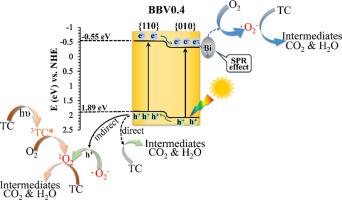当前位置:
X-MOL 学术
›
Surf. Interfaces
›
论文详情
Our official English website, www.x-mol.net, welcomes your feedback! (Note: you will need to create a separate account there.)
Bi/BiVO4 tailoring molecular oxygen activation for SPR-promoted photocatalytic contaminant removal
Surfaces and Interfaces ( IF 6.2 ) Pub Date : 2024-03-19 , DOI: 10.1016/j.surfin.2024.104210 Zhaoyong Bian , Bobing Lu , Yajing Yang , Qiang Zhang
Surfaces and Interfaces ( IF 6.2 ) Pub Date : 2024-03-19 , DOI: 10.1016/j.surfin.2024.104210 Zhaoyong Bian , Bobing Lu , Yajing Yang , Qiang Zhang

|
In recent years, photocatalytic technology has been gained widespread attention in contaminants removal due to its green, low-carbon, sustainable properties. Bismuth vanadate (BiVO) with decahedral shapes has emerged as a promising photocatalyst with unique photoinduced charges directional transfer. In this study, a simple wet chemical reduction method was used to load stable Bi nanoparticles in situ on the surface of decahedral BiVO to enhance the charges movement for molecular oxygen activation and tetracycline photodegradation. The formed Bi nanoparticles induced abundant oxygen vacancy defect states and surface plasmon resonance effects on BiVO nanoparticles surface. In aid of the special function of a surface heterojunction, decahedral BiVO can be photoexcited to produce more photogenerated carriers, and its separation efficiency is greatly improved, thus enhancing both the oxidative activity and photocatalytic activity. In the photocatalytic degradation process, superoxide radicals (∙O) showed the most significant contribution, and singlet oxygen (O) played junior role in tetracycline hydrochloride (TC) removal. O is obtained by ∙O and hole energy conversion, and some of it is produced by tetracycline photodecomposition under alkaline conditions. The BBV0.4 photocatalytic system has the best catalytic activity under weakly alkaline conditions, and the synergistic effect of photocatalysis and photodecomposition greatly improves the mineralization rate of TC. The large numbers of ∙O and O reactive oxygen species produced by BBV0.4 activation of oxygen play a crucial role in the photodegradation of TC via demethylation, deoxidation, deamination, ring-opening, and carbonylation to complete mineralization. This work studies in depth the change in the decahedral BiVO photocatalytic mechanism caused by the in situ introduce of bismuth metal, providing an efficient and environmentally friendly reference method for the rapid removal of tetracycline hydrochloride under alkaline conditions.
中文翻译:

Bi/BiVO4 定制分子氧活化用于 SPR 促进的光催化污染物去除
近年来,光催化技术以其绿色、低碳、可持续的特性在污染物去除领域受到广泛关注。具有十面体形状的钒酸铋(BiVO)已成为一种有前途的光催化剂,具有独特的光诱导电荷定向转移。在本研究中,采用简单的湿化学还原方法将稳定的Bi纳米粒子原位负载在十面体BiVO表面,以增强分子氧活化和四环素光降解的电荷运动。形成的 Bi 纳米颗粒在 BiVO 纳米颗粒表面诱导了丰富的氧空位缺陷态和表面等离子体共振效应。借助表面异质结的特殊功能,十面体BiVO可以被光激发产生更多的光生载流子,其分离效率大大提高,从而增强氧化活性和光催化活性。在光催化降解过程中,超氧自由基(∙O)表现出最显着的贡献,单线态氧(O)在盐酸四环素(TC)的去除中发挥次要作用。 O是通过∙O与空穴能量转换得到的,其中一部分是在碱性条件下四环素光分解产生的。 BBV0.4光催化体系在弱碱性条件下具有最佳的催化活性,光催化和光分解的协同作用大大提高了TC的矿化率。 BBV0.4活化氧产生的大量∙O和O活性氧在TC通过去甲基化、脱氧、脱氨、开环和羰基化完成矿化的光降解过程中发挥着至关重要的作用。该工作深入研究了原位引入金属铋引起的十面体BiVO光催化机理的变化,为碱性条件下快速去除盐酸四环素提供了高效、环保的参考方法。
更新日期:2024-03-19
中文翻译:

Bi/BiVO4 定制分子氧活化用于 SPR 促进的光催化污染物去除
近年来,光催化技术以其绿色、低碳、可持续的特性在污染物去除领域受到广泛关注。具有十面体形状的钒酸铋(BiVO)已成为一种有前途的光催化剂,具有独特的光诱导电荷定向转移。在本研究中,采用简单的湿化学还原方法将稳定的Bi纳米粒子原位负载在十面体BiVO表面,以增强分子氧活化和四环素光降解的电荷运动。形成的 Bi 纳米颗粒在 BiVO 纳米颗粒表面诱导了丰富的氧空位缺陷态和表面等离子体共振效应。借助表面异质结的特殊功能,十面体BiVO可以被光激发产生更多的光生载流子,其分离效率大大提高,从而增强氧化活性和光催化活性。在光催化降解过程中,超氧自由基(∙O)表现出最显着的贡献,单线态氧(O)在盐酸四环素(TC)的去除中发挥次要作用。 O是通过∙O与空穴能量转换得到的,其中一部分是在碱性条件下四环素光分解产生的。 BBV0.4光催化体系在弱碱性条件下具有最佳的催化活性,光催化和光分解的协同作用大大提高了TC的矿化率。 BBV0.4活化氧产生的大量∙O和O活性氧在TC通过去甲基化、脱氧、脱氨、开环和羰基化完成矿化的光降解过程中发挥着至关重要的作用。该工作深入研究了原位引入金属铋引起的十面体BiVO光催化机理的变化,为碱性条件下快速去除盐酸四环素提供了高效、环保的参考方法。



























 京公网安备 11010802027423号
京公网安备 11010802027423号